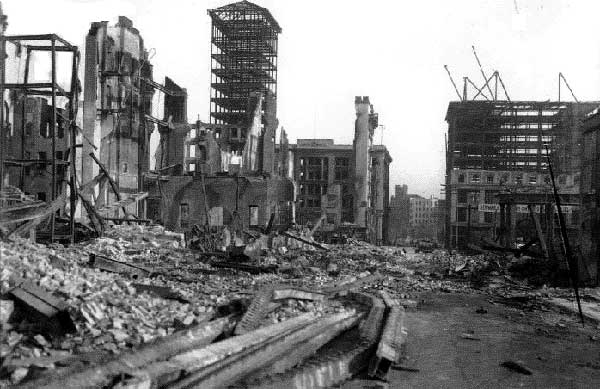
April 18, 1906 at 5:12 AM San Francisco was struck by a devastating earthquake. Gas and water lines ruptured, and by the mid-afternoon a super heated fire started consuming the city. The San Francisco Fire Department, perhaps the world's best equipped and trained fire fighting force, was helpless, lacking any water to stop the raging fire. In attempt to mount containment and rescue missions, San Francisco firefighters were incinerated in "fire proof" skyscrapers.
Chaos and anarchy was subdued, perhaps illegally, by troops under General Funston's command. The army shot looters on sight and in a desperate attempt to stop the fast spreading fire, dynamited and shelled buildings to create firebreaks. Over 400,000 people were left homeless, and the city government and military deliberately under reported the death toll to 700. The true toll of over 3,000 killed would not be determined until the 1980s, when an enterprising historian simply counted the headstones marked April 1906.
The San Francisco earthquake was perhaps the first mass natural disaster caught on film, yet attitudes were different in that era, certainly more rooted in the 19th century rather than the 20th. In the public squares and parks, the homeless people living in tents were not pitiful refugees or survivors, and instead of being portrayed as traumatized victims they were San Franciscans simply making do in frontier fashion in much the same way as the '49ers had. Instead of providing grief counseling, the government press ganged citizens into work crews. No one thought it strange or out of place that the press tycoon William Randolph Hearst made his way to the charred and smoldering remains of the city in order to provide the latest news and impressions of the devastation:"The hills rolled to the seas as bare as when the pioneers landed in '49. But now they are a blackened waste. North to the bay, west to the Mission -- nothing but ruins. The wholesale district is destroyed, the manufacturing district, the financial district, and the waterfront section -- all destroyed."
San Francisco rose again from the ashes and celebrated its re-birth by hosting the the 1915 World's Fair. The war in Europe was far away, and San Franciscans had fought their own battle and had won. While Europe would never be the same, San Francisco regained its position as one of the leading cities of commerce, culture, and finance in the Pacific. No San Franciscan could imagine that their shining, modern city would one day be eventually eclipsed by Los Angeles.
I used to see the gathering of earthquake survivors at the downtown commemoration. Their numbers diminished every year, and I imagine the turnout will be sparser this year. The earthquake survivors provided us with memories not only of the earthquake, but of what San Francisco once was before two world wars and a half century of social change.
Naturally, there was speculation back then that the earthquake was sign of divine retribution. Before North Beach and the Castro district, there had been the wicked Barbary Coast, and many preachers connected the earthquake to San Francisco's tolerance of human nature. To refute this view, Herb Caen always loved to re-print this old and true ditty:
"If, as they say, God spanked this town
For being much too frisky,
Why did He burn His churches down
And save Hotaling's Whiskey?"
Indeed, the firestorm somehow bypassed Hotaling's warehouse on Jackson St. saving thousands of barrels of flammable liquor.
2 comments:
OK, here's the scenario as I see it. God does want to spank San Fran. But he is a merciful god, so he lets the whiskey supply survive, as he knows (being all knowing God after all) that everyone can do with a good stiff drink after working hard all day to rebuild the city.
I'm doing an assignment on this
Post a Comment